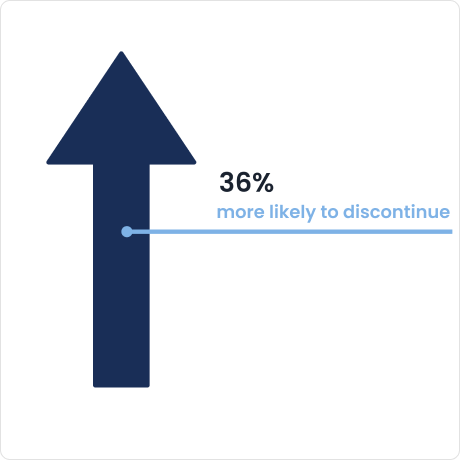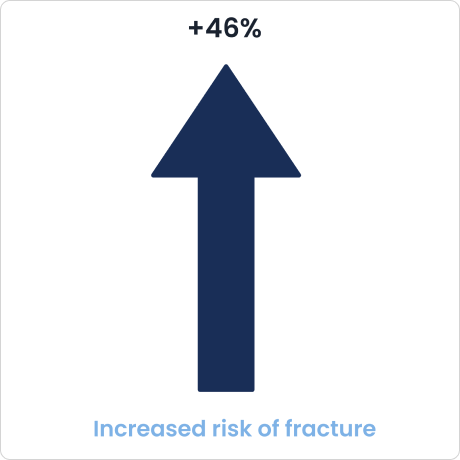The treatment of osteoporosis faces a significant challenge: adherence. Studies reveal that compliance and persistence with prescribed treatment regimens are very low. Approximately 50% of patients do not follow their treatment as prescribed and/or discontinue their medication within the first year. This adherence gap poses a serious obstacle to effective osteoporosis management, leading to an increased risk of fractures and additional healthcare costs.1

Side Effects Are a Further Reason for Discontinuing Therapy and Have Significant Impact Patient Willingness to Continue Treatment
Osteoporosis Is Called a “Silent” Disease” Because There Are Typically No Symptoms Until a Bone Is Broken
Complicated Dosing Schedules Can Discourage Patients, Especially if They Do Not See Immediate Benefits
One of the Primary Reasons for Discontinuing Therapy, Gastrointestinal Side Effects Significantly Impact Patient Willingness to Continue Treatment
Side Effects Are a Further Reason for Discontinuing Therapy and Have Significant Impact Patient Willingness to Continue Treatment
Osteoporosis Is Called a “Silent” Disease” Because There Are Typically No Symptoms Until a Bone Is Broken
Complicated Dosing Schedules Can Discourage Patients, Especially if They Do Not See Immediate Benefits
One of the Primary Reasons for Discontinuing Therapy, Gastrointestinal Side Effects Significantly Impact Patient Willingness to Continue Treatment
Side Effects Are a Further Reason for Discontinuing Therapy and Have Significant Impact Patient Willingness to Continue Treatment
Osteoporosis Is Called a “Silent” Disease” Because There Are Typically No Symptoms Until a Bone Is Broken
Complicated Dosing Schedules Can Discourage Patients, Especially if They Do Not See Immediate Benefits
One of the Primary Reasons for Discontinuing Therapy, Gastrointestinal Side Effects Significantly Impact Patient Willingness to Continue Treatment
Side Effects Are a Further Reason for Discontinuing Therapy and Have Significant Impact Patient Willingness to Continue Treatment
Osteoporosis Is Called a “Silent” Disease” Because There Are Typically No Symptoms Until a Bone Is Broken
Complicated Dosing Schedules Can Discourage Patients, Especially if They Do Not See Immediate Benefits
One of the Primary Reasons for Discontinuing Therapy, Gastrointestinal Side Effects Significantly Impact Patient Willingness to Continue Treatment
Side Effects Are a Further Reason for Discontinuing Therapy and Have Significant Impact Patient Willingness to Continue Treatment
Osteoporosis Is Called a “Silent” Disease” Because There Are Typically No Symptoms Until a Bone Is Broken
Complicated Dosing Schedules Can Discourage Patients, Especially if They Do Not See Immediate Benefits
One of the Primary Reasons for Discontinuing Therapy, Gastrointestinal Side Effects Significantly Impact Patient Willingness to Continue Treatment
One of the critical challenges in managing osteoporosis is ensuring patient adherence to prescribed treatments. Improved adherence can significantly enhance outcomes by reducing the incidence of fractures among high-risk populations. Strategies to improve adherence include patient education, simplifying treatment regimens, and addressing side effects.


Healthcare providers play a crucial role in closing the adherence gap in osteoporosis treatment. By recognizing the barriers to adherence and addressing them proactively, providers can significantly impact patient outcomes. Women experiencing gastrointestinal events are 36% more likely to discontinue bisphosphonates, highlighting the need for targeted interventions. Through personalized care, ongoing support, and education, healthcare professionals can guide patients towards better adherence and ultimately, better health outcomes.2
Non-adherence to osteoporosis treatment has tangible and detrimental effects. Notably, poor bisphosphonate compliance is associated with a 46% increase in the risk of fracture. This adherence gap poses a serious obstacle to effective osteoporosis management, leading to an increased risk of fractures and additional healthcare costs.3

1. IOF international osteoporosis foundation https://www.osteoporosis.foundation/health-professionals/treatment
2. Modi A, et al. Association between gastrointestinal events and persistence with osteoporosis therapy: analysis of administrative claims of a U.S. managed care population. J Manag Care Spec Pharm. 2015;21:499–506.
3. Hernlund E et al. Osteoporosis in the European Union: medical management, epidemiology and economic burden. Arch Osteoporos 2013;8:136.